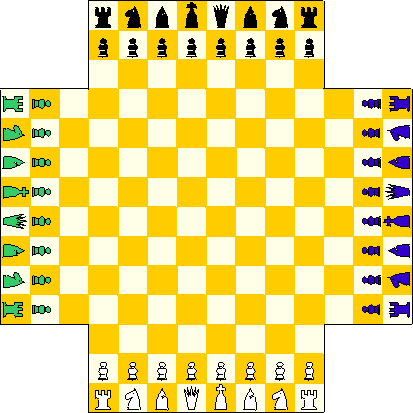Four Handed Chess II
September 22, 1881, Captain George Hope Verney wrote in the Times on Four Handed Chess. Inspired by the many responses he received, he published a booklet on the game later that year.The text of this booklet can be seen on this website.
Rules of Verney's game
Verney's game has the same opening setup as that of the variant from Dessau; i.e. each side has three added rows and queens start on white squares.

Again, players that sit opposite of each other form a team. Turns alternate in clockwise order.
The object of the game is to mate both kings of the opponents. All other outcomes are a draw.
When a player is mated, his pieces may not move but may also not be captured, neither by the opponents, nor by the partner of the player. Also, these pieces are considered not to give check.
Pawns have no initial double step. When they are blocked by a pawn from the partner, they may jump over it. This may also be done when both pawns move in the same direction. (E.g., when white has a pawn on e5 and partner black has a pawn on e6, the white pawn could jump from e5 to e7, when e7 is empty.) When a pawn reaches the end of the board, he reverses direction. Pawns only promote when they reach a square at the back rows of the opponents. In such a case, the pawn promotes to a queen (no minor promotion is possible.)
There is no castling. After the first move of white, the other team may decide to switch seats (i.e., the player that played green now plays blue and vice versa.) Other rules are as in orthodox chess.
Popularity of Verney's game
Verney's game quickly gained popularity, e.g., in the United States. Most notable however is the formation of the Four-handed Chess Club of London: in 1883/4, Verney founded this club, which was inaugurated October 13, 1885 with 80 members. The club existed till the second World War, i.e., it existed more than half a century!The rules of Hughes-Hughes
In 1888, M. E. Hughes-Hughes proposed slightly modified rules for the game. These quickly became the standard in the Four-handed Chess Club.
The board and opening setup
The board consists of an 8 by 8 board, with at all four sides an extension of size 8 by 3 added. The board is checkered, with a black square in the left-most corner(s). Each of the four players has a normal set of pieces, in four different colours, clockwise: black, yellow, red, white (drawn in different colors in the picture below).

Note that the queen is always on the left side of the king in the opening setup.
Other rules
Players, sitting opposite of each other are partners, i.e., white and yellow form a team, and black and red form a team.
Black starts, and players then make moves in clockwise order.
Pawns may advance two squares initially, as in normal chess. (This was one of the modifications of Hughes: Verney's game forbids an initial double step.)
Pawns promote only on the last ranks of the opponents, and only to queen. When a pawn reaches the last rank of his partners row (or one of the other four fields where the edge of the board obstructs its move), then it reverses direction, and moves further in the opposite direction. When it again would reach the last rank, it again reverses direction, etc. When a pawn's move is obstructed by a pawn of its partner, it can leap over it, provided the square it moves to is vacant. This is possible, even when both pawns move in the same direction. (Mark pawns going in the opposite direction to keep track which direction they are going.)
When a player is checkmated, he may not move, and he must pass his turns. His pieces remain on the board, and may not be captured. These pieces do not give check.
A mated player can be released from mate, either by his opponents, or (more commonly) by his partner. When a player releases an opponent from mate, he may not do this by capturing one of the pieces of the mated player.
The team that checkmates both opponents wins the game. All other outcomes (except of course when a team resigns) are a draw.
More
Read also about a modern variant where every player plays for himself:Purchase Equipment for this Game


Written by Hans Bodlaender.
WWW page created: May 4, 2000. Text partly written 1995, partly written 2000.